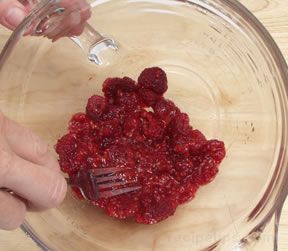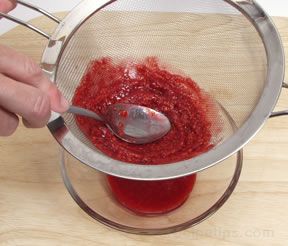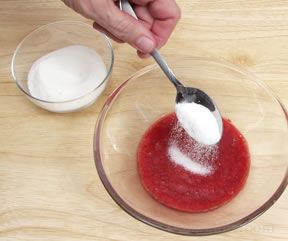|
Raspberry Preparation | Raspberry Coulis | Tips
| Raspberries |
|
 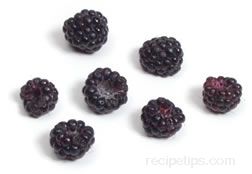
| Red Raspberry |
Black Raspberry |
A small, deep colored berry, generally red, which has a tender texture, a sweet flavor that is slightly tart, and a pleasant aroma. Its flavor is stronger than most other types of berries. The berries grow on a thorny, woody branched bush. The berry consist of a group of smaller fruits that are called drupelets, which each contain a tiny seed. The drupelets are clustered together around a central core. When picked from the bush the core remains on the bush, leaving the raspberry hollow at the base, which leaves the berry quite fragile. The most common and most cultivated variety is the red raspberry. However, other varieties exist which include the purple-flowering, the black raspberry and the golden raspberry. Other berries that are related to the raspberries and often considered to be the same fruit are the wild raspberries and the Arctic brambleberry. |
|
Uses:
Fresh raspberries are delicious eaten on their own, over ice cream, mixed with yogurt or just topped with a little sugar and cream. They can be used in many of the same ways in which strawberries are used. Many recipes can have raspberries substituted for strawberries. Raspberries are used in salads, puddings, cakes, tarts, and other desserts. They are added as a topping on cereal, waffles, and pancakes. Raspberries are used to flavor vinegar, and are also used to flavor, wine, champagne, liqueurs, and spirits. They can also be cooked and made into jellies and jams. |
| At Their Best:
Peak season for raspberries is during the middle of summer, but they are available year-round in some markets as both fresh and frozen. |
|
How to Buy:
When selecting raspberries, choose those that are plump, slightly soft, have a deep color, and good aroma. Avoid overly soft and dull-colored berries. If buying in a container, check the bottom to see if it is stained or leaking juice, which will indicate that they are too soft and overripe. The best way to get raspberries is to pick your own. Select bright even colored berries. When the berries are ripe they should pull off the hull easily. Be sure to pick ripe raspberries because they do not ripen once they are picked. |
| Storage:
Raspberries are very perishable and should not be exposed to the sun or warm temperatures for a long period of time. It is best to eat them the same day that they are purchased or picked. They can be stored in the refrigerator for one or two days. To store, place unwashed berries in a single layer, on a tray or platter that is lined with paper towels and store uncovered in the refrigerator. Sprinkling with a little sugar will also help preserve them longer. Whole raspberries freeze well and can be frozen up to a year. To freeze, place the berries in a single layer on a cookie sheet and place in the freezer. Once they are frozen place them in a airtight freezer proof container. Use a container that will protect the berries from being damaged while being stored in the freezer. |
| Varieties: |
|
Red Raspberry

|
The red raspberry is the most common and popular raspberry. Their peak season is generally more towards the end of the summer into fall. They seem to produce better in the cooler weather. The berries are larger and less seedy in comparison to the black raspberries. The bright red berries are sweet and juicy. Red raspberries are used in desserts, made into sauces, jellies and jams, served as a topping on ice cream, pancakes and waffles, and is used to flavor many other food items. One of the best ways to eat them is fresh out-of-hand. |
|
Black Raspberry

|
The black raspberry has a distinctively black color, is typically found in forests and field areas, and is referred to as the blackcap raspberry, a name derived from its distinctive cap-like shape. Prior to ripening, the black raspberry will have a white to pink color and then becomes increasingly deeper and darker in color as it ripens. This berry is most often used for pies, desserts, jellies, jams, wines, liqueurs, and tea. |
| Purple-Flowering Raspberry |
The purple-flowering raspberry is generally found growing wild in country forests, fields, and hedgerows. The fruit has a flat dome-shaped appearance with a faded red coloring. It is not as sweet as the red variety but is very tasty when sweetened and served as a dessert. The purple-flowering raspberry bush adds adds beauty to the location in which it is planted, with its continuous blossoming of purple flowers from June through September. |
| Purple Raspberry |
A hybrid of the black and red raspberry is known as the purple raspberry, taking on the purple overtone, but having the same texture as the black or red and a mildly sweet flavor. |
|
Golden Raspberry
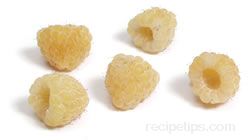 |
The golden raspberry is not a common berry and is most often produced in limited quantities to be served as a dessert berry. This variety has a bright gold to orange color, a typical raspberry texture and a plump round meaty fruit. |
| Wild Raspberry |
The wild raspberries, which grow abundantly but are smaller in size, are similar in texture and flavor of both black or red varieties. They grow easily in forest fields and hedgerows, providing many berries for wildlife and harvesters seeking the sweet flavor of the wild berry. |
| Arctic Brambleberry |
The Arctic brambleberry is a very scarce variety and has the same shape and similar size as the wild red or black raspberry, but is red in color. It has a closer resemblance to the black raspberry than the red in taste, size and appearance; however, the brambleberry provides a slightly sweeter and more robust flavor than other raspberries. |
Raspberry Preparation
Raspberries are very fragile and must be handle with care to avoid bruising. Bruising will deteriorate the quality of the berry. Raspberries are generally fairly clean and do not need to be washed. If they must be washed, do not wash until just before they are to be used. Expose them to water for as little time as possible to prevent them from absorbing too much water and becoming mushy.
|
If it is necessary to clean the raspberries, wash them just before using. Gently rinse with cold water, using as little water as possible. Drain and carefully spread out on a dry paper towel. |
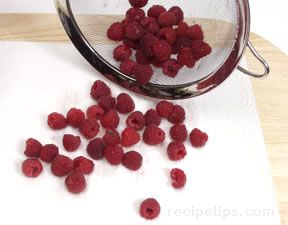 |
| Remove any damaged berries or unwanted debris. Prepare in desired manner as soon as possible once they have been washed. |
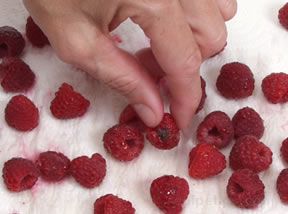 |
Raspberry Coulis
Raspberries can be crushed and sugar added to produce a sauce or coulis to use in desserts, such as cakes, custards, puddings, ice cream, and sorbets. See information below on how to make raspberry coulis.
Tips
- Adding sugar, lemon juice, or orange juice to raspberries will help preserve their bright color.
- Avoid washing raspberries if possible. If it is necessary, use as little water as possible to prevent the raspberries from absorbing too much water and becoming mushy.
- If picking your own raspberries, pick berries off gently to avoid bruising and pick in the morning for sweeter, longer lasting berries.
- One pint of fresh raspberries is equal to 1 3/4 cups.
|










